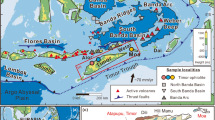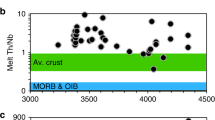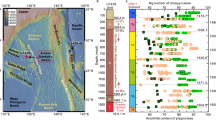Abstract
The Lizard complex of south Cornwall consists of an assemblage of peridotites, gabbros, hornblende schists, metasediments, dolerites and metadolerites and acid-basic banded gneisses (the Kennack gneisses). It is bordered to the north by a zone of chaotic sediments with phacoidal inclusions of pillow lavas, greywackes and quartzites (the so-called Meneage crush zone). This zone can be traced eastwards into the Roseland district of south Cornwall1. The age of the complex is uncertain. Dates (largely K–Ar) obtained from the Kennack Gneiss and the majority of hornblende schists are mainly between 370 and 390 Myr, although Green2,3considered the peridotite to be older than the oldest date obtained from the hornblende schists, at 492 Myr. Metadolerite dykes have recently4 been given ages of approximately 400 Myr. All the above are thought to represent minimum ages due to the possibility of argon loss during subsequent uplift, cooling and mild metamorphism. Since the work of Green3, the Lizard complex has been regarded by many as the type example of a hot diapiric mantle intrusion into continental crust. Intrusion is thought to have occurred during a period of regional metamorphism and to have resulted in the imposition of a contact dynamothermal aureole on the hornblende schists at the margin of the peridotite body. The gabbro is regarded as a later and unrelated intrusion, and the Kennack gneisses were attributed to intrusion of acid magma along sheared basic dykes in peridotite. Thayer5 suggested that the complex was ophiolitic, basing his views on the field relationships of gabbros and peridotites which indicated that the two lithologies might be temporally and genetically related. General comparisons have since been made between the Lizard complex and the well-documented ophiolote sequences6–10, although little detail has generally been given. I provide here relevant details which suggest that the Lizard complex is ophiolitic in origin.
This is a preview of subscription content, access via your institution
Access options
Subscribe to this journal
Receive 51 print issues and online access
$199.00 per year
only $3.90 per issue
Buy this article
- Purchase on Springer Link
- Instant access to full article PDF
Prices may be subject to local taxes which are calculated during checkout
Similar content being viewed by others
References
Barnes, R. P., Andrews, J. A. & Badham, J. P. N. Proc. Ussher Soc. (in the press).
Miller, J. A. & Green, D. H. Nature 192, 1175 (1961).
Green, D. H. in Present Views on Some Aspects of the Geology of Devon and Cornwall (ed. Hosking, K. F. G. & Shrimpton, G. J.) 87, (R. Geol. Soc., Com. Penzance, 1964).
Halliday, A. N. & Mitchell, J. G. Proc. Ussher Soc. 4, 24 (1977).
Thayer, T. P. Bull. Geol. Soc. Am. 80, 1515 (1969).
Strong, D. F., Stevens, R. K., Malpas, J. & Badham, J. P. N. Proc. Ussher Soc. 3, 252 (1975).
Bromley, A. V. Proc. Ussher Soc. 2, 508 (1973).
Bromley, A. V. Proc. geol. Soc. 132, 114 (1976).
Badham, J. P. N. & Kirby, G. A. Bull. Soc. geol. Fr. 18, 885 (1976).
Kirby, G. A. Geol. Mag. 115, 199 (1978).
Frey, F. A. Geochim. cosmochim. Acta 33, 1429 (1969).
Flett, J. S. & Hill, J. B. Mem. geol. Surv. U.K. (1946).
Kirby, G. A. thesis, Univ. Southampton (1979).
Gass, I. E. Nature 220, 39 (1968).
Williams, H. & Smythe, W. R. Am. J. Sci. 273, 594 (1973).
Dietz, R. S. in Continental Drift (ed. Runcorn, S. K.) 289, (Academic, New York, 1962).
Coleman, R. G. J. geophys. Res. 76, 1212 (1971).
Cann, J. R. Geophys. J. R. astr. Soc. 39, 169 (1974).
Sleep, N. H. J. geophys. Res. 80, 4037 (1975).
Dewey, J. F. & Kidd, W. S. F. Bull. geol Soc. Am. 88, 960 (1977).
Floyd, P. A., Lees, G. J. & Parker, A. Proc. Ussher Soc. 3, 414 (1976).
Floyd, P. A. J. Petrol. 17, 522 (1976).
Floyd, P. A. Proc. geol. Ass. Can. 83, 385 (1972).
Johnson, G. A. L. Proc. geol. Ass. Can. 84, 237 (1973).
Burret, C. F. Nature 239, 155 (1972).
Laurent, R. Int. Geol. Congr. (24th Session) 3, 363 (1972).
Burne, R. V. Nature phys. Sci. 241, 129 (1973).
Pearce, J. A. & Cann, J. R. Earth planet. Sci. Lett. 19, 290 (1973).
Floyd, P. A. & Winchester, J. A. Earth planet. Sci. Lett. 27, 211 (1975).
Author information
Authors and Affiliations
Rights and permissions
About this article
Cite this article
Kirby, G. The Lizard complex as an ophiolite. Nature 282, 58–61 (1979). https://doi.org/10.1038/282058a0
Received:
Accepted:
Issue Date:
DOI: https://doi.org/10.1038/282058a0
This article is cited by
-
Ridge axis deformation and coeval melt migration within layer 3 gabbros: evidence from the Lizard Complex, U.K.
Contributions to Mineralogy and Petrology (1995)
-
A Sm-Nd isotopic study of 500 Ma old oceanic crust in the Variscan belt of Western Europe: the Chamrousse ophiolite complex, Western Alps (France)
Contributions to Mineralogy and Petrology (1987)
-
Carboniferous submarine volcanism at Herbornseelbach (Lahn-Dill area, Germany)
Geologische Rundschau (1987)
-
The Lizard complex as an ophiolite
Nature (1980)
Comments
By submitting a comment you agree to abide by our Terms and Community Guidelines. If you find something abusive or that does not comply with our terms or guidelines please flag it as inappropriate.



